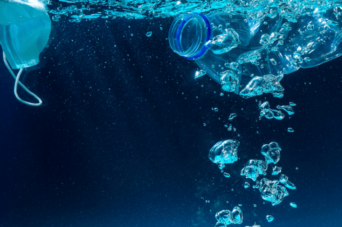Why should plastic waste be collected at sea?
Manta Project
Plastic pollution
Science
25 January 2024
To act against plastic pollution, it is important to reduce the production of plastic at source and collect waste present in nature. Scientific data confirms the usefulness of collection, both at sea and on land.

To introduce the subject, let’s take a telling image: imagine that you have a water leak in your kitchen. To remedy this, the first instinct is to act at the source by turning off the tap, changing the seal or blocking the pipe. Then there is a second step: Use a mop to remove the water spilled on the floor. To act against plastic pollution, it’s the same: it is important to reduce the production of plastic at source and to collect waste present in nature to have a concrete impact now. Today scientific data confirms the usefulness of collection, both at sea and on land.
When waste invades the coastal zone
The path of plastics in the water cycle and the Ocean is an important subject for research. Depending on their density, the waste will evolve on the surface, in the water column or at the bottom of the oceans. They will be subjected to the wind, numerous sea currents and waves, carrying them to the bottom of the oceans or offshore, trapped by the concentric currents of the ocean gyres.
According to modeling work by The Ocean Cleanup (1), 43% of macroplastic waste arriving in the Ocean sinks to the bottom while 57% floats. The latter would then engage in several cycles during which part of the waste would be deposited on the coasts. The remainder, subject to the wind, numerous sea currents and waves, would be carried to the bottom of the oceans or offshore, trapped by the concentric currents of the ocean gyres, and would gradually degrade.

In 2021, a study (2) estimates that between 67% and 77% of plastic waste is found on beaches and in coastal waters (up to 10 km offshore). In 2023, another study (3) establishes that 62% of macroplastics entering the Ocean are found on the surface. Note that this study only takes into account floating macroplastics whose density is greater than that of sea salt, therefore excluding waste present in the water column and on the seabed.
These studies and modeling agree that more than half of the macroplastics that arrive in the ocean float, return to beaches or remain in coastal areas for several cycles. By collecting them at this precise time and place, before they sink or drift offshore, we limit the production of microparticles that are too complex to collect.
Furthermore, the models (1) show that even if we stop emitting macroplastics into the ocean (light blue curve), microplastics coming from the degradation of macroplastics already present in the Ocean continue to grow, and this during at least 30 years.


It is therefore necessary to have a concrete impact on ocean pollution to act at the source, by limiting the entry of plastic waste into the water cycle but also to collect wild waste.
Beyond the preventive aspect, the action of The SeaCleaners is characterized by the development of innovative solutions: MANTA and MOBULA. These unique prototypes in the world will make it possible to collect plastic waste before it degrades too much.
Collect on land before dispersal at sea
Once in nature, plastic waste continues to degrade, pollute ecosystems and emit greenhouse gases (mainly ethylene and methane). By picking them up on land, we can interrupt their journey through the water cycle.
A recent study by NORCE, one of Norway’s largest research organizations, showed that land-based waste collection had an impact on the amount of microplastics in the environment. Over the course of a year, volunteers collected bottles, bags and other large pieces of plastic from the shores of an island near Bergen. The amount of microplastics on land and in water has dropped by 99.5%!
Scientists believe that high UV levels and temperatures on shorelines and in shallow waters cause plastic fragments to degrade much more quickly in these locations.
Collection on land and at sea therefore has not only an environmental benefit, but also an educational one! Participating in waste collection operations, in town, in the countryside, on land or at sea, allows you to see the significant quantities of waste present in nature, to realize that it is essentially products from our own daily consumption and can arouse the desire to take concrete action.
Bibliography :
- Lebreton, L., Egger, M. & Slat, B. A global mass budget for positively buoyant macroplastic debris in the ocean. Sci. Rep. 9, 12922 https://www.nature.com/articles/s41598-019-49413-5 (2019).
- Onink, V., Jongedijk, C., Hoffman, M., van Sebille, E. & Laufkötter, C. Global simulations of marine plastic transport show plastic trapping in coastal zones. Environ. Res. Lett. https://doi.org/10.1088/1748-9326/abecbd (2021).
- Mikael L. A. Kaandorp, Delphine Lobelle, Christian Kehl, Henk A. Dijkstra & Erik van Sebille. Global mass of buoyant marine plastics dominated by large long-lived debris. https://www.nature.com/articles/s41561-023-01216-0 (2023)
- Gunhild Bødtker, Marte Haave, Gaute Velle, Gidske L. Andersen, Alessio Gomiero, Rune Gaasø, Kenneth Bruvik og Eivind Bastesen, NORCE rapport 6-2023. https://www.norceresearch.no/assets/images/prosjekter/Lisle-Lyng%C3%B8y/Rapport-6-2023-NORCE-Klima-og-milj%C3%B8_HMF11432.pdf?v=1693814487
